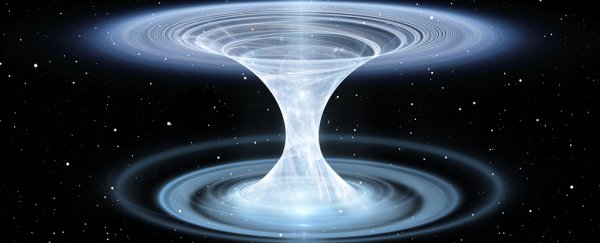The humble wormhole is a science fiction perennial, often depicted as looping tunnels beyond gaping whirlpools of light. In reality, nobody has much of an idea what these things might really look like - but now, we have a tantalising new prospect.
A Russian physicist has come up with a way to estimate the physical characteristics of such a hypothetical structure, working backwards from what we know about light and the ringing of space.
Phenomena such as black holes and their theoretical two-faced cousin, wormholes, are places where our experience of physics lets us down. The best we can hope for is to indirectly measure their influence on the things we can observe.
Roman Konoplya from the Peoples Friendship University of Russia (RUDN University) started with the geometry of rippling spacetime to come up with a better way of describing these unimaginable structures. Not that it makes them any easier for us to picture.
"Here we shall show how to reconstruct the shape function of a spherically symmetric traversable Lorenzian wormhole near its throat if one knows high frequency quasinormal modes of the wormhole," Konoplya writes.
Got that? Ok, so the specific details of his analysis aren't for amateur wormhole enthusiasts. But here's a simple break-down of what this means.
According to Einstein's general relativity and Maxwell's equations on electromagnetic radiation - the latter of which give us information on the speed of light - space and time behave as if they have a single, physical nature.
This is all well and good until you follow the predictions of general relativity through to their natural conclusion, where 'spacetime' can be pinched into points of infinite density - black holes, if you will.
In 1916, Austrian physicist Ludwig Flamm played with the same mathematics to show how space could distort to also prevent the inflow of information, leading to a 'white hole'.
Fast forward twenty years, when Einstein worked with a fellow physicist named Nathan Rosen to show how the two theoretical phenomena could technically be linked. Joined together, information going into a black hole could come out somewhere else in spacetime through a white hole.
Voilà, wormholes!
The most likely candidates for such links would be tiny black holes that pop in and out of existence. Keeping a tiny wormhole open long enough for something to pass through would require some considerable tugging on space, and right now nothing we know of is up to that mighty task.
What's more, we still don't really know how spacetime behaves beyond a given point. That means we don't actually know how things like mass or distance change as you move towards the heart of a black hole, or – in this case – down the throat of a wormhole.
Konoplya thinks the key to understanding the shape of the bottleneck between black and white holes lies in the way energy dissipates through space in waves.
With the recent observation of gravitational waves ringing across the cosmos following the collisions of black holes and neutron stars, physicists have confirmed how energy is carried away by distortions in spacetime.
Fading ripples of energy are described in physics as quasinormal modes. Starting with a specific class of assumptions about the symmetries of wormholes, Konoplya figured we can know a fair bit about wormholes once we establish the high-frequency quasinormal modes that could ring from their throats.
Knowing this, he used quantum mechanics to determine how lightwaves might stretch in the distortions of electromagnetic fields surrounding the black hole at their doorstep to get some idea of what the wormhole might look like.
The concept isn't perfect, not least because it relies on a bunch of assumptions, but also because any answers we did come up with still wouldn't pinpoint an answer.
"In general terms a quantum mechanical approach leads to many solutions for the geometry of a wormhole," Konoplya admits.
But it's a solid place to start, and can be expanded once other quantum fields are taken into account, potentially giving us yet another possible way to detect them.
With research surrounding gravitational waves leaping ahead, it's feasible the elusive traversable wormhole might one day join black holes as a reality. For the time being, we can keep the pretty tunnels of light.
This research was published in Physics Letters B.
